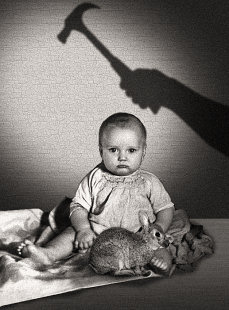
Doctor Watson's Phobia Factory
 In the early decades of the twentieth century the discipline of psychology was still in its infancy, but beginning to make significant headway. Pioneering researchers were enthusiastically unraveling the human mind, and some were willing to go to alarming lengths to satisfy their curiosity.
In the early decades of the twentieth century the discipline of psychology was still in its infancy, but beginning to make significant headway. Pioneering researchers were enthusiastically unraveling the human mind, and some were willing to go to alarming lengths to satisfy their curiosity.
One such trailblazer was a behaviorist named John B. Watson. In 1919, his curiosity was aroused after observing a child who showed an irrational fear of dogs. Watson supposed that a shiny new human would not possess an inborn fear of domesticated animals, but if "one animal succeeds in arousing fear, any moving furry animal thereafter may arouse it." In order to satiate his scientific appetite, he undertook a series of experiments at Johns Hopkins University to determine whether an infant could indeed be conditioned to fear cute-and-cuddly animals by associating them with scary stimuli. A couple decades earlier Pavlov's notorious dogs had been conditioned to salivate at the sound of a bell; Watson hoped to expand upon the concept.
In 1920 Watson secured access to a "healthy, stolid, and unemotional" nine-month-old infant named Albert B., the son of a wet nurse who worked in the hospital. He was assisted by Rosalie Rayner, a graduate student at the university. The researchers' first order of business was to establish a psychological baseline. They tried exposing the infant to a white rat, a rabbit, a dog, and a monkey, and Albert reached for each animal with cheerful curiosity. The researchers brought him items such as masks and clumps of cotton, and he manipulated the objects with interest. They placed a long steel rod behind Albert's head and struck the metal sharply with a claw hammer, and he flinched with evident distress. The infant's baseline reactions to these stimuli were duly noted, and two months later the peculiar series of "joint stimulation" experiments was underway. Excerpts from Dr. Watson's notes outline its progression:
Age: 11 months, 3 days
* White rat suddenly taken from the basket and presented to Albert. Just as his hand touched the animal the bar was struck immediately behind his head. The infant jumped violently and fell forward, burying his face in the mattress.
* Just as the right hand touched the rat the bar was again struck. Again the infant jumped violently, fell forward and began to whimper.
Age: 11 months, 10 days
* Rat presented suddenly without sound. When the rat nosed the infant's left hand, the hand was immediately withdrawn. It is thus seen that the two joint stimulations given the previous week were not without effect.
* Joint stimulation. Fell over immediately to right side and began to whimper.
* Rat alone. The instant the rat was shown the baby began to cry. Almost instantly he turned sharply to the left, fell over on left side, raised himself on all fours and began to crawl away so rapidly that he was caught with difficulty before reaching the edge of the table.
Watson also wondered whether Albert would transfer these acquired fears to other animals or objects. After a five-day furlough, additional experimentation ensued:
Age: 11 months, 15 days
* Rat alone. Whimpered immediately, withdrew right hand and turned head and trunk away.
* Rabbit alone. Negative responses began at once. He leaned as far away from the animal as possible, whimpered, then burst into tears. When the rabbit was placed in contact with him he buried his face in the mattress, then got up on all fours and crawled away.
* Fur coat (seal). Withdrew immediately to the left side and began to fret. Coat put close to him on the left side, he turned immediately, began to cry and tried to crawl away on all fours.
* [A lab assistant] brought the Santa Claus mask and presented it to Albert. He was again pronouncedly negative.
Age: 11 months, 20 days
* Rat alone. Withdrawal of the whole body, bending over to left side, no crying. Fixation and following with eyes. It was thought best to freshen up the reaction by another joint stimulation.
* Just as the rat was placed on his hand the rod was struck. Reaction violent.
* Rabbit alone. Leaned over to left side as far as possible. Began to whimper.
* When the rabbit was left on Albert's knees for a long time he began tentatively to reach out and manipulate its fur with forefingers. While doing this the steel rod was struck. A violent fear reaction resulted.
* Rabbit alone. Started immediately to whimper, holding hands far up, but did not cry.
More Reading
Doctor Watson's Phobia Factory
John B. Watson - Wikipedia, the free encyclopedia
John B. Watson Biography
WATSON’S EXPERIMENT- nomal healthy boy named Albert
 “Give me a dozen healthy infants, well-formed, and my own specified world to bring them up and I’ll guarantee to take any one at random and train him to become any type of specialist I might select—doctor, lawyer, merchant-chief, and yes, even beggar man and thief, regardless of his talents, penchants, tendencies, abilities, vocations, and race of his ancestors.” (1930 John B. Watson)
“Give me a dozen healthy infants, well-formed, and my own specified world to bring them up and I’ll guarantee to take any one at random and train him to become any type of specialist I might select—doctor, lawyer, merchant-chief, and yes, even beggar man and thief, regardless of his talents, penchants, tendencies, abilities, vocations, and race of his ancestors.” (1930 John B. Watson)John B. Watson Bilingual School <<<---- Guys!! this site is worth to read! - Jai







Post a Comment